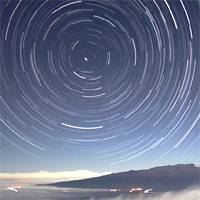Paths of the Stars

Because the earth is rotating the sky appears to rotate. Viewed from above the north pole, the earth is rotating counter-clockwise. For an observer on the earth, objects move from east to west (this is true for both northern and southern hemispheres). More accurately put, when looking north, objects in the sky move counter-clockwise.
Though all objects rotate in the sky, the observed path stars make in the sky depend on the observer's latitude. Some are always in the observer's sky, some some of the time, and others are never observable. These different ways of classifying stars are discussed below.
During the rotation of the earth, some stars rise from below the eastern horizon and later set below the western horizon. Appropriately enough, these stars are called rise and set stars. They are indicated by the yellow star trails in the animation to the left.
The angle rise and set stars (including the sun) make with the horizon as they rise is the same for all rise and set stars for that observer. Specifically, the angle is 90° - |observer's latitude|. They make this same angle in west. In the northern hemisphere the angle is tilted towards the south and in the southern hemisphere the angle is tilted towards the north.
Stars near the celestial poles make small circles and may not pass the horizon plane. If they are always above the horizon they are called circumpolar stars. If they are always below the horizon they are never rise stars. Circumpolar stars for the northern hemisphere are never-rise stars for the southern hemisphere and vice versa. These stars are indicated by blue (northern hemisphere stars) and red (southern hemisphere stars) in the figure to the left.